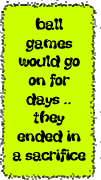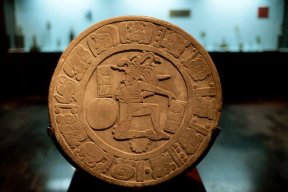bug tacos |
arts
|
dance | hairless dogs | textiles | stone tree | marriage | jade | trading |
ceramics | aztecs
 |
 |
| Book Store |

|
Chichen Itza, one
of the largest sites near Cancun, Mexico, has a ball game
court. It is larger than nction for the ancient Maya. There were two teams -- the number of players depended on the region where the game was played. Most ball courts had two sloping parallel walls inset with three round disks called markers or a single stone ring, at right angles to the ground. The game appears in various myths, sometimes as a struggle between day and night
deities, or the battles between the gods in the sky and the lords of the
underworld. The ball symbolized the sun, moon, or stars, and the rings
stood for sunrise and sunset, or equinoxes. These games could go on for days. It was played on an odd shaped field. The object of the game was to move a hard rubber ball without the use of hands or feet. It wasn't real hard to keep score, since it took so long to get the ball through the stone hoop. The losing team was usually sacrificed. |
|
| At page top: hoop in ball court at Chichen Itza. Shown at right, stone carving of a ball player. |  |







 a football field --at about 150 by 40 feet --
it is the largest in the Mundo Maya. The ball game, which was a common
activity of all Mesoamerican peoples and originated about 3,000 B.C.,
had a ritualistic fun
a football field --at about 150 by 40 feet --
it is the largest in the Mundo Maya. The ball game, which was a common
activity of all Mesoamerican peoples and originated about 3,000 B.C.,
had a ritualistic fun